2024成都中考英语试题研究 语篇研读 课件(共42张PPT)
文档属性
| 名称 | 2024成都中考英语试题研究 语篇研读 课件(共42张PPT) | 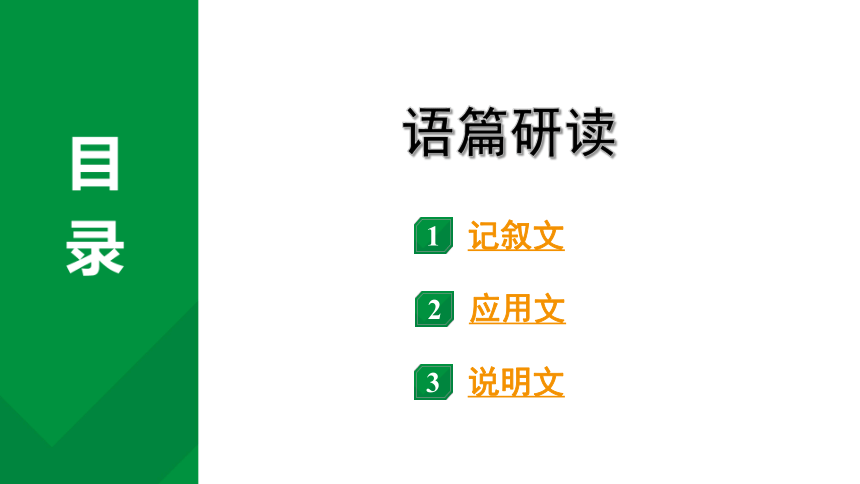 | |
| 格式 | pptx | ||
| 文件大小 | 573.9KB | ||
| 资源类型 | 教案 | ||
| 版本资源 | 通用版 | ||
| 科目 | 英语 | ||
| 更新时间 | 2023-12-23 21:27:34 | ||
图片预览

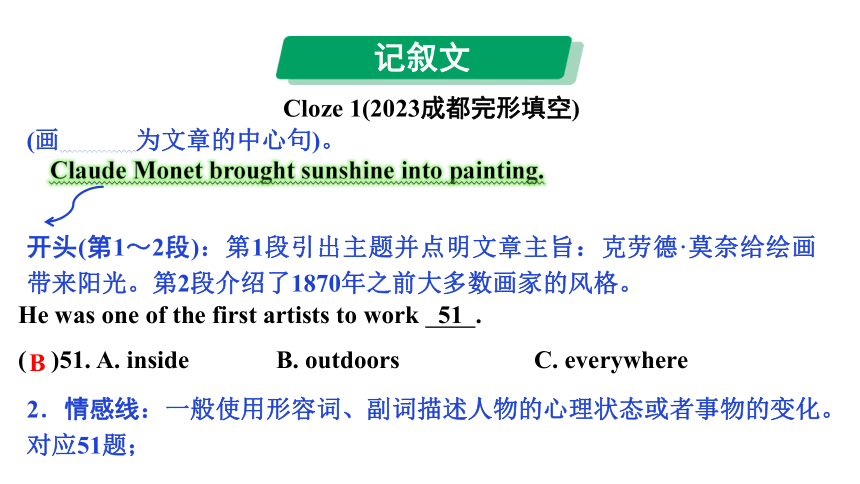
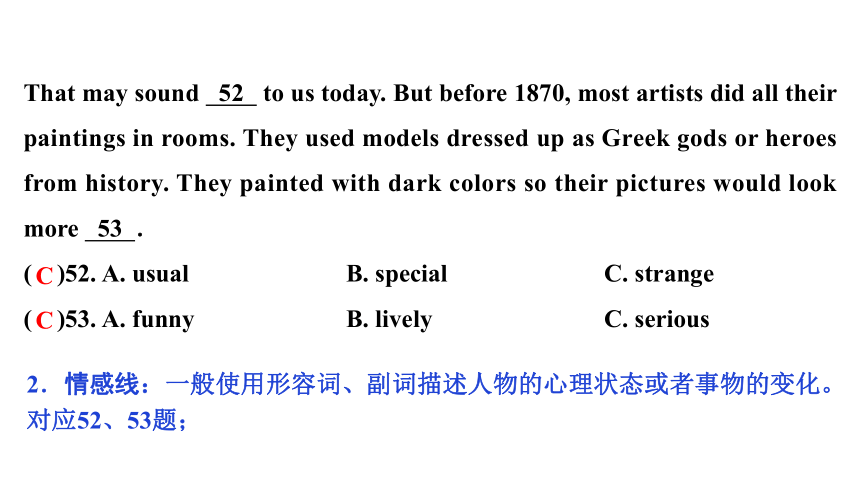

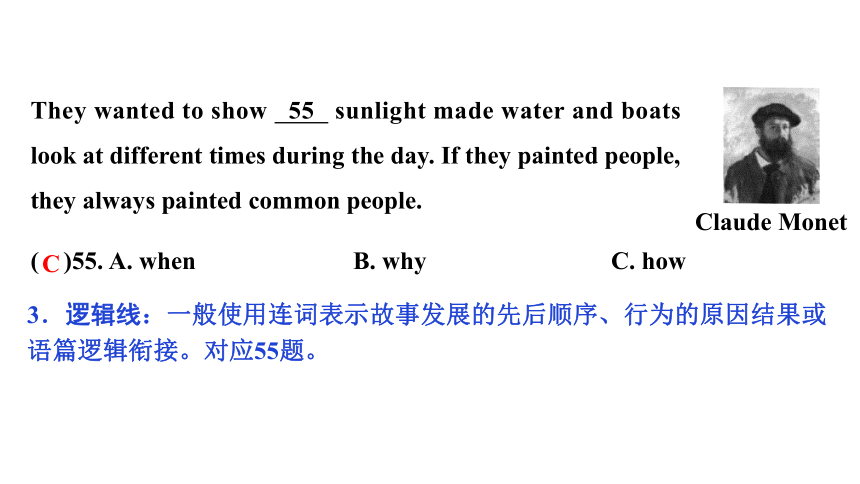
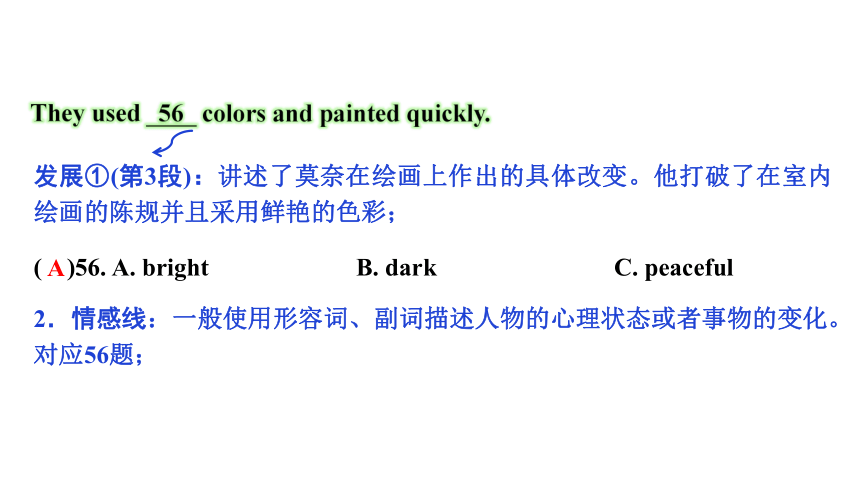
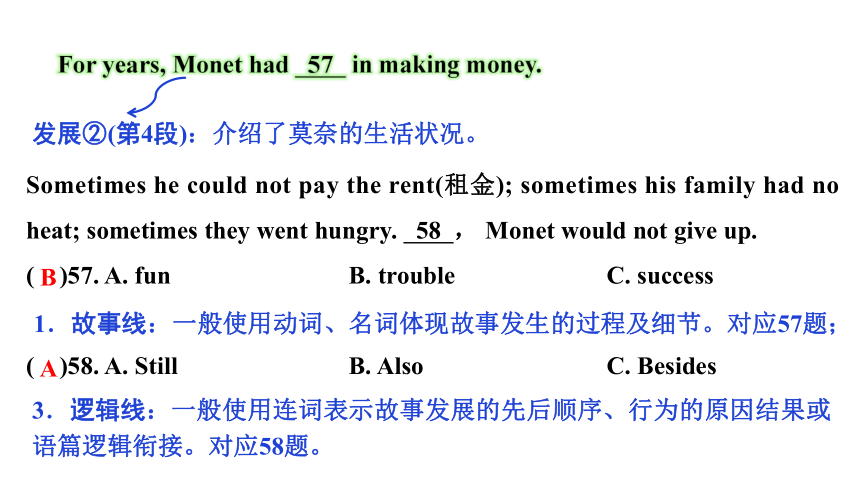
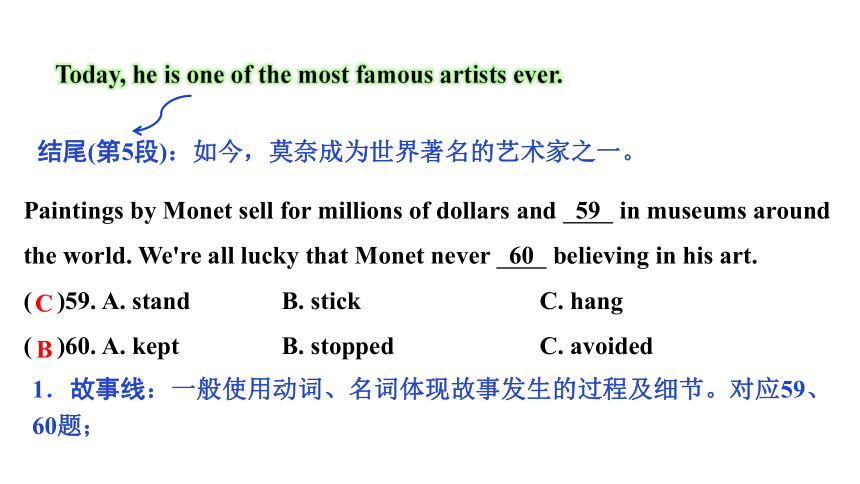
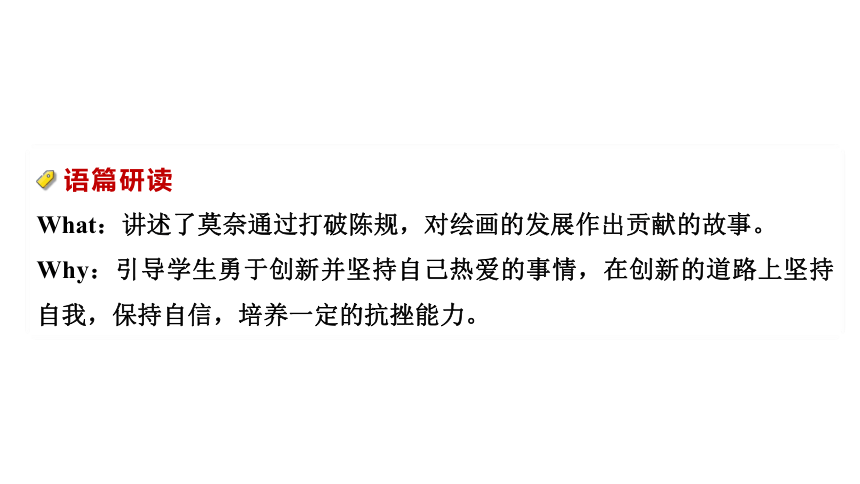


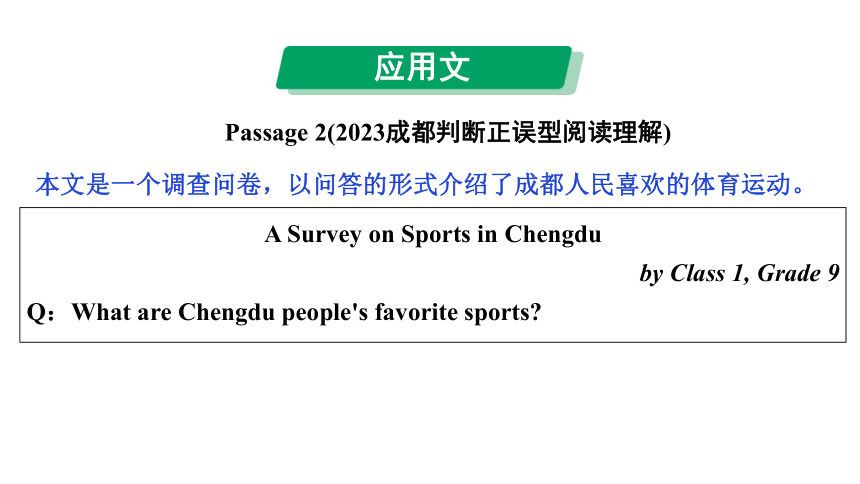
文档简介
(共42张PPT)
语篇研读
2
应用文
1
记叙文
3
说明文
记叙文
Cloze 1(2023成都完形填空)
Claude Monet brought sunshine into painting.
开头(第1~2段):第1段引出主题并点明文章主旨:克劳德·莫奈给绘画带来阳光。第2段介绍了1870年之前大多数画家的风格。
He was one of the first artists to work 51 .
( )51. A. inside B. outdoors C. everywhere
2.情感线:一般使用形容词、副词描述人物的心理状态或者事物的变化。对应51题;
B
(画 为文章的中心句)。
That may sound 52 to us today. But before 1870, most artists did all their paintings in rooms. They used models dressed up as Greek gods or heroes from history. They painted with dark colors so their pictures would look more 53 .
( )52. A. usual B. special C. strange
( )53. A. funny B. lively C. serious
C
C
2.情感线:一般使用形容词、副词描述人物的心理状态或者事物的变化。对应52、53题;
However, Monet and his artist friends 54 the rules. They took their paints and brushes to paint lakes, flowers and woods in the open air.
发展①(第3段):讲述了莫奈在绘画上作出的具体改变。他打破了在室内绘画的陈规并且采用鲜艳的色彩;
( )54. A. supported B. broke C. followed
B
1.故事线:一般使用动词、名词体现故事发生的过程及细节。对应54题;
They wanted to show 55 sunlight made water and boats look at different times during the day. If they painted people, they always painted common people.
Claude Monet
( )55. A. when B. why C. how
C
3.逻辑线:一般使用连词表示故事发展的先后顺序、行为的原因结果或语篇逻辑衔接。对应55题。
They used 56 colors and painted quickly.
发展①(第3段):讲述了莫奈在绘画上作出的具体改变。他打破了在室内绘画的陈规并且采用鲜艳的色彩;
( )56. A. bright B. dark C. peaceful
A
2.情感线:一般使用形容词、副词描述人物的心理状态或者事物的变化。对应56题;
For years, Monet had 57 in making money.
Sometimes he could not pay the rent(租金); sometimes his family had no heat; sometimes they went hungry. 58 , Monet would not give up.
( )57. A. fun B. trouble C. success
( )58. A. Still B. Also C. Besides
发展②(第4段):介绍了莫奈的生活状况。
B
A
1.故事线:一般使用动词、名词体现故事发生的过程及细节。对应57题;
3.逻辑线:一般使用连词表示故事发展的先后顺序、行为的原因结果或语篇逻辑衔接。对应58题。
Today, he is one of the most famous artists ever.
Paintings by Monet sell for millions of dollars and 59 in museums around the world. We're all lucky that Monet never 60 believing in his art.
( )59. A. stand B. stick C. hang
( )60. A. kept B. stopped C. avoided
结尾(第5段):如今,莫奈成为世界著名的艺术家之一。
C
B
1.故事线:一般使用动词、名词体现故事发生的过程及细节。对应59、60题;
语篇研读
What:讲述了莫奈通过打破陈规,对绘画的发展作出贡献的故事。
Why:引导学生勇于创新并坚持自己热爱的事情,在创新的道路上坚持自我,保持自信,培养一定的抗挫能力。
语篇研读
How:
①文体特征:记叙文。
②写作手法:作者以“Claude Monet brought sunshine into painting.”开头,吸引读者的注意,激发读者的兴趣,让读者想深入了解莫奈如何给绘画带来阳光;此外,文章使用了一些表示时间顺序的词(组)“before 1870”,“For years”,“Today”等让学生清晰地领会莫奈一生不同时期对于自己绘画风格的坚持以及现在人们对于莫奈及其作品的态度。并且通过“But”,“However”等连词的使用,使莫奈的做法和当时 绘画界的主流情况形成鲜明的对比,使语篇逻辑更紧凑。
语篇研读
③语言特点:第4段三次使用“sometimes ”描述了莫奈生活中遇到的困难,和本段最后一句呼应,体现了莫奈在困境中坚持自己绘画风格的顽强精神。
应用文
Passage 2(2023成都判断正误型阅读理解)
A Survey on Sports in Chengdu
by Class 1, Grade 9
Q:What are Chengdu people's favorite sports
本文是一个调查问卷,以问答的形式介绍了成都人民喜欢的体育运动。
Walking is No.1 favorite. Another four most popular sports are running,ping pong,swimming and badminton.
(1)问答一的第一、二句说明了成都人民喜爱的运动。对应61题。
61. The top three popular sports in Chengdu are .
【What】61题为细节理解题。61需要根据题干定位至原文问答中的细节。
Greenways and parks near their homes are green gifts for Chengduers to do sports conveniently.
(2)问答一的第三句说明了成都人民运动场所的情况。对应62题。
62. Places for sports are easy to find in Chengdu.
【What】62题为细节理解题。62需要根据题干定位至原文问答中的细节。
Q:Do Chengdu people do sports
just to lose weight
Not really. Physical shape doesn't
matter that much.The chart on the right
shows the reasons for exercise.
这个图表用来展示调查问卷的结果,使文章的结构更加清晰明了。根据图表中的百分比可知运动的原因。对应63、64题。
63. The chart shows that about a quarter of Chengduers exercise to spend time with family.
64. We can learn that hobby is more important than fashion for Chengduers to do sports.
【What】63、64题需从调查问卷中的图表获取信息,要求学生关注数字,熟练对应并转换题干文字和图表信息。
Q:Do Chengdu people use much technology when doing sports
Yes. Technology, such as smart watches, sports apps or smart gyms,is used to record exercise habits,provide suggestions,give reports on health and even remind people to do sports.
(3)问答三说明了科技用于记录日常体育锻炼。对应65题。
65. Technology is smart but hardly used in daily exercise.
【What】65题均为细节理解题。65需要根据题干定位至原文问答中的细节。
语篇研读
What:介绍了成都人民喜欢的运动以及喜欢的原因。
Why:帮助学生全面了解当前流行的运动方式,呼吁青少年们积极参与体育运动,增强体魄。
语篇研读
How:
①文体特征:应用文——调查问卷。
②文章结构:本文以调查问卷的形式展开,分别罗列了“Chengdu people's favorite sports, Reasons for exercise, Do Chengdu people use much technology when doing sports”三个问题及调查结果。
③写作手法:调查问卷中运用了问答的形式,帮助读者了解受欢迎的 运动方式以及科技对于运动的辅助作用。通过列图表,直观、快速地让读者了解做运动的各个原因,激发读者对体育运动的兴趣。
语篇研读
④语言特点:在回答中使用“No.1 ”,“Not really.”,“Yes.”等简洁的语言,体现了问答形式的口语化特点;在回答中列举了多种运动以及科技手段,有利于使读者联系实际,进一步吸引读者的兴趣。
命题引导教学
语篇类型——调查问卷(2023成都判断正误型阅读理解)
变化点解读:2023年判断正误型阅读理解新考查“调查问卷”这一语篇类型。
命题立意:考查学生在多样、真实、具体的情景中理解语篇内容的能力。符合2022年版课标语篇知识内容要求 三级 第三条“理解常见应用文 语篇和其他常见语篇类型的主要写作目的、结构特征、基本语言特点和信息组织方式,并用以传递信息”的要求。
Passage 3(2023成都阅读理解B)
Locals Care for Natural World
Grasslands and lakes in Sanjiangyuan have taken on a new look and many wild animals have come back.
第一个表格第一句说明了三江源生态环境的变化,并点明了环境变化和野生动物生存之间的关系;第五个表格介绍了科学家用真菌战胜塑料 污染。对应71题。
本文以五个小表格的形式展开,每个表格的小标题都用加粗形式标注,
能够帮助读者快速捕捉关键信息。
On January 24, 2003, China set up Sanjiang yuan National Nature Reserve to protect the area and the wildlife. Local people joined in the project, picking up waste and protecting the animals.
China Successfully Grows Rice in Space
How to grow food in space if humans live there one day For nearly 40 years, China has developed over 260 new types of seeds(种子) in space.
Recently growing rice at Tiangong Space Station makes a big step forward. It can also solve food problems on Earth.
第二个表格第二句说明了太空种植的发展时间和情况。对应第72题。
Doctors Sent to West Africa
Doctors are flying to an island off the coast of West Africa after a new flu broke out.
They will test different medicines to find a way to deal with it. To get things better, they will also offer medical care and help train local nurses there.
第三个表格第一句说明了医生们去西非海岸的目的,是下一句it指代的 对象。对应73题。
▲ .
A strong earthquake hit Turkey on February 6. More than 8,000 international rescuers(救援人员) around the world went to help, including the Blue Sky Rescue Team from China. They helped save lives and rebuild homes.
第四个表格标题设空,引导学生带着问题阅读。第四个表格第一句说明了地震发生的时间和地点。第二、三句说明了救援的人员和具体的做法。对应74题。
Scientists Fight against Plastic Pollution
A natural material, fungi(真菌), used to break down a type of plastic called polypropylene turned out to be useful. Scientists at the University of Sydney found that after 90 days, between 25% and 27% of polypropylene broke down and after 140 days, polypropylene became completely safe.
( )71. Which passages are about environmental protection
A. a,b B. a,e C. b,e
( )72. When did China probably begin to develop seeds in space
A. In the 1980s. B. In the 1990s. C. In the 2000s.
【What】71题为细节理解题,需要搜索题干关键词,对应文中细节进行回答。
【How】72题为数字计算题。根据第二个表格中“For nearly 40 years...in space.”可知,到目前,中国已经培育太空种子将近40年了。需要在第二个表格寻找关键信息的基础上,通过计算得出答案。
B
A
( )73. What does the underlined word it in Passage c refer to
A. An island. B. A new flu. C. Medical care.
( )74. Which is the best title for ▲
A. Turkey Calling for Help
B. The World Saving Lives in Quake
C. Terrible Situation Faced by Turkey
【How】73题为代词指代题。需要根据第三个表格的内容,联系代词出现位置的上下文,明确指代对象。
【What】74题为标题归纳题。需要阅读第四个表格把握文章主旨,推断合适的标题。
B
B
命题引导教学(2023.73)
变化点解读:2023年73题新增代词指代题。
命题立意:考查学生根据句子或段落间的信息关系来推测名词或代词的指代关系的能力,本题符合2022年版课标中“辨别语篇中的衔接手段,判断语篇中句子之间、段落之间的逻辑关系”的要求。
命题引导教学(2023.74)
变化点解读:2023年74题考查标题归纳题。通过标题设空的新形式考查学生把握语篇内在逻辑和总结概括的能力。
命题立意:此题考查学生的阅读理解能力和归纳总结能力。符合2022年版课标中“阅读名人传记和报刊文章时,整体理解和简要概括所读内容”的要求。
( )75. What's the theme shared by all the passages
A. Challenges and Chances.
B. Responsibility and Success.
C. Problems and Efforts.
【What】75题为文章主题题,需要根据文章各部分标题、具体内容总结大意。
C
语篇研读
What:介绍了在环境保护、太空探索、人类健康、自然灾害方面发生的一些重要事件。
Why:提高学生对世界的关注度和责任感,引导学生探索未知、保护 环境及自我。
语篇研读
How:
①文本特征:应用文——表格。
②写作手法:除设空外,每个表格均有标题帮助学生快速了解文章内容;第二个表格第一句通过提问的方式引出下文“中国在太空种植方面取得的成就”。
语篇研读
③语言特点:语言简洁有力;使用了一般过去时、现在完成时、现在 进行时、一般将来时等多种不同的时态来实现作者表达的意图。用一般过去时介绍已经发生的事件,用现在完成时说明事件对人类生活的影响,用现在进行时描述正在发生的事件,突出时间的紧急性,用一般将来时介绍将要发生的事情。
说明文
Passage 4(2023成都补全短文)
Money may not buy happiness, but it helps. Many teenagers want to learn how to manage money before going out into the world.
第二句说明了许多青少年想学会如何理财。第四句介绍了一位专家给出了聪明对待金钱的建议。对应1题。
A. Spend your money wisely.
B. Be smart with your money.
C. Set a goal of saving money.
D. Save your money in the long run.
E. Agree on the value of different jobs before you start.
F. Write down how much money you have and what you are spending.
(画 为文章的中心句)。
第1段:以具体的情况引出管理金钱的主题。
1.______ This idea is raised by Dr. Mara Harvey, a money expert. The following are some of her tips.
Learn to make money. Ask parents or neighbors if you can do chores to make pocket money.
A. Spend your money wisely.
B. Be smart with your money.
C. Set a goal of saving money.
D. Save your money in the long run.
E. Agree on the value of different jobs before you start.
F. Write down how much money you have and what you are spending.
第2~5段:分别介绍了理财的四个技巧。
These could include washing a car or taking the dog for a walk.
2.____ In this way, you can also improve your communication skills, which will help when you have a grown up job, too.
第二段第三句说明了赚钱的不同工作,下句应与对待不同工作的态度及其价值评价有关。对应2题。
A. Spend your money wisely.
B. Be smart with your money.
C. Set a goal of saving money.
D. Save your money in the long run.
E. Agree on the value of different jobs before you start.
F. Write down how much money you have and what you are spending.
Help your money grow. Money can't grow if it's sitting inside a piggy bank. Put your money in the bank and you can get interest(利息).
3._____ One day you may feel surprised at how much money you have.
第三段第三句说明了人们可以把钱存在银行这一理财方法,下句应与长期储蓄相关。对应3题。
A. Spend your money wisely.
B. Be smart with your money.
C. Set a goal of saving money.
D. Save your money in the long run.
E. Agree on the value of different jobs before you start.
F. Write down how much money you have and what you are spending.
Make a plan.
If you have a big event, such as a holiday coming up, it might mean you will need to spend more of your pocket money. Try making a plan for spending and saving. 4.________ Then it will help you take control of your money.
第四段第一句说明了制定计划这一控制花钱的方法。对应4题。
A. Spend your money wisely.
B. Be smart with your money.
C. Set a goal of saving money.
D. Save your money in the long run.
E. Agree on the value of different jobs before you start.
F. Write down how much money you have and what you are spending.
5. _______ Figure out how much you can reasonably spend each month. Spend your money on what you truly need. Then try to cut down on spending. For example, rather than eating out, you can choose to cook at home.
第五段说明了管理金钱的具体方法。设空为本段中心句。对应5题。
A. Spend your money wisely.
B. Be smart with your money.
C. Set a goal of saving money.
D. Save your money in the long run.
E. Agree on the value of different jobs before you start.
F. Write down how much money you have and what you are spending.
【What】
1~5题均采用了联系上下文的微技能,需要在把握文章整体的基础上,
仔细阅读设空前后的句子,分析前后句之间的具体联系。
语篇研读
What:介绍了青少年理财的四个技巧。
Why:引导学生了解理财常识,培养理财意识,制定合理的消费计划。
How:①文体特征:说明文。
②文章结构:
语篇研读
③写作手法:开篇以青少年渴望学会管理金钱的情况引起读者共鸣,从而引出本文话题“金钱管理”;第一段最后一句承上启下,点明下文是与 金钱管理有关的技巧。
④语言特点:第二至五段的段首句均为祈使句,号召力强;使用动词(组)如“Ask, Agree on, Put, Try making a plan, Figure out, cut down”等给出具体的理财方式。
语篇研读
2
应用文
1
记叙文
3
说明文
记叙文
Cloze 1(2023成都完形填空)
Claude Monet brought sunshine into painting.
开头(第1~2段):第1段引出主题并点明文章主旨:克劳德·莫奈给绘画带来阳光。第2段介绍了1870年之前大多数画家的风格。
He was one of the first artists to work 51 .
( )51. A. inside B. outdoors C. everywhere
2.情感线:一般使用形容词、副词描述人物的心理状态或者事物的变化。对应51题;
B
(画 为文章的中心句)。
That may sound 52 to us today. But before 1870, most artists did all their paintings in rooms. They used models dressed up as Greek gods or heroes from history. They painted with dark colors so their pictures would look more 53 .
( )52. A. usual B. special C. strange
( )53. A. funny B. lively C. serious
C
C
2.情感线:一般使用形容词、副词描述人物的心理状态或者事物的变化。对应52、53题;
However, Monet and his artist friends 54 the rules. They took their paints and brushes to paint lakes, flowers and woods in the open air.
发展①(第3段):讲述了莫奈在绘画上作出的具体改变。他打破了在室内绘画的陈规并且采用鲜艳的色彩;
( )54. A. supported B. broke C. followed
B
1.故事线:一般使用动词、名词体现故事发生的过程及细节。对应54题;
They wanted to show 55 sunlight made water and boats look at different times during the day. If they painted people, they always painted common people.
Claude Monet
( )55. A. when B. why C. how
C
3.逻辑线:一般使用连词表示故事发展的先后顺序、行为的原因结果或语篇逻辑衔接。对应55题。
They used 56 colors and painted quickly.
发展①(第3段):讲述了莫奈在绘画上作出的具体改变。他打破了在室内绘画的陈规并且采用鲜艳的色彩;
( )56. A. bright B. dark C. peaceful
A
2.情感线:一般使用形容词、副词描述人物的心理状态或者事物的变化。对应56题;
For years, Monet had 57 in making money.
Sometimes he could not pay the rent(租金); sometimes his family had no heat; sometimes they went hungry. 58 , Monet would not give up.
( )57. A. fun B. trouble C. success
( )58. A. Still B. Also C. Besides
发展②(第4段):介绍了莫奈的生活状况。
B
A
1.故事线:一般使用动词、名词体现故事发生的过程及细节。对应57题;
3.逻辑线:一般使用连词表示故事发展的先后顺序、行为的原因结果或语篇逻辑衔接。对应58题。
Today, he is one of the most famous artists ever.
Paintings by Monet sell for millions of dollars and 59 in museums around the world. We're all lucky that Monet never 60 believing in his art.
( )59. A. stand B. stick C. hang
( )60. A. kept B. stopped C. avoided
结尾(第5段):如今,莫奈成为世界著名的艺术家之一。
C
B
1.故事线:一般使用动词、名词体现故事发生的过程及细节。对应59、60题;
语篇研读
What:讲述了莫奈通过打破陈规,对绘画的发展作出贡献的故事。
Why:引导学生勇于创新并坚持自己热爱的事情,在创新的道路上坚持自我,保持自信,培养一定的抗挫能力。
语篇研读
How:
①文体特征:记叙文。
②写作手法:作者以“Claude Monet brought sunshine into painting.”开头,吸引读者的注意,激发读者的兴趣,让读者想深入了解莫奈如何给绘画带来阳光;此外,文章使用了一些表示时间顺序的词(组)“before 1870”,“For years”,“Today”等让学生清晰地领会莫奈一生不同时期对于自己绘画风格的坚持以及现在人们对于莫奈及其作品的态度。并且通过“But”,“However”等连词的使用,使莫奈的做法和当时 绘画界的主流情况形成鲜明的对比,使语篇逻辑更紧凑。
语篇研读
③语言特点:第4段三次使用“sometimes ”描述了莫奈生活中遇到的困难,和本段最后一句呼应,体现了莫奈在困境中坚持自己绘画风格的顽强精神。
应用文
Passage 2(2023成都判断正误型阅读理解)
A Survey on Sports in Chengdu
by Class 1, Grade 9
Q:What are Chengdu people's favorite sports
本文是一个调查问卷,以问答的形式介绍了成都人民喜欢的体育运动。
Walking is No.1 favorite. Another four most popular sports are running,ping pong,swimming and badminton.
(1)问答一的第一、二句说明了成都人民喜爱的运动。对应61题。
61. The top three popular sports in Chengdu are .
【What】61题为细节理解题。61需要根据题干定位至原文问答中的细节。
Greenways and parks near their homes are green gifts for Chengduers to do sports conveniently.
(2)问答一的第三句说明了成都人民运动场所的情况。对应62题。
62. Places for sports are easy to find in Chengdu.
【What】62题为细节理解题。62需要根据题干定位至原文问答中的细节。
Q:Do Chengdu people do sports
just to lose weight
Not really. Physical shape doesn't
matter that much.The chart on the right
shows the reasons for exercise.
这个图表用来展示调查问卷的结果,使文章的结构更加清晰明了。根据图表中的百分比可知运动的原因。对应63、64题。
63. The chart shows that about a quarter of Chengduers exercise to spend time with family.
64. We can learn that hobby is more important than fashion for Chengduers to do sports.
【What】63、64题需从调查问卷中的图表获取信息,要求学生关注数字,熟练对应并转换题干文字和图表信息。
Q:Do Chengdu people use much technology when doing sports
Yes. Technology, such as smart watches, sports apps or smart gyms,is used to record exercise habits,provide suggestions,give reports on health and even remind people to do sports.
(3)问答三说明了科技用于记录日常体育锻炼。对应65题。
65. Technology is smart but hardly used in daily exercise.
【What】65题均为细节理解题。65需要根据题干定位至原文问答中的细节。
语篇研读
What:介绍了成都人民喜欢的运动以及喜欢的原因。
Why:帮助学生全面了解当前流行的运动方式,呼吁青少年们积极参与体育运动,增强体魄。
语篇研读
How:
①文体特征:应用文——调查问卷。
②文章结构:本文以调查问卷的形式展开,分别罗列了“Chengdu people's favorite sports, Reasons for exercise, Do Chengdu people use much technology when doing sports”三个问题及调查结果。
③写作手法:调查问卷中运用了问答的形式,帮助读者了解受欢迎的 运动方式以及科技对于运动的辅助作用。通过列图表,直观、快速地让读者了解做运动的各个原因,激发读者对体育运动的兴趣。
语篇研读
④语言特点:在回答中使用“No.1 ”,“Not really.”,“Yes.”等简洁的语言,体现了问答形式的口语化特点;在回答中列举了多种运动以及科技手段,有利于使读者联系实际,进一步吸引读者的兴趣。
命题引导教学
语篇类型——调查问卷(2023成都判断正误型阅读理解)
变化点解读:2023年判断正误型阅读理解新考查“调查问卷”这一语篇类型。
命题立意:考查学生在多样、真实、具体的情景中理解语篇内容的能力。符合2022年版课标语篇知识内容要求 三级 第三条“理解常见应用文 语篇和其他常见语篇类型的主要写作目的、结构特征、基本语言特点和信息组织方式,并用以传递信息”的要求。
Passage 3(2023成都阅读理解B)
Locals Care for Natural World
Grasslands and lakes in Sanjiangyuan have taken on a new look and many wild animals have come back.
第一个表格第一句说明了三江源生态环境的变化,并点明了环境变化和野生动物生存之间的关系;第五个表格介绍了科学家用真菌战胜塑料 污染。对应71题。
本文以五个小表格的形式展开,每个表格的小标题都用加粗形式标注,
能够帮助读者快速捕捉关键信息。
On January 24, 2003, China set up Sanjiang yuan National Nature Reserve to protect the area and the wildlife. Local people joined in the project, picking up waste and protecting the animals.
China Successfully Grows Rice in Space
How to grow food in space if humans live there one day For nearly 40 years, China has developed over 260 new types of seeds(种子) in space.
Recently growing rice at Tiangong Space Station makes a big step forward. It can also solve food problems on Earth.
第二个表格第二句说明了太空种植的发展时间和情况。对应第72题。
Doctors Sent to West Africa
Doctors are flying to an island off the coast of West Africa after a new flu broke out.
They will test different medicines to find a way to deal with it. To get things better, they will also offer medical care and help train local nurses there.
第三个表格第一句说明了医生们去西非海岸的目的,是下一句it指代的 对象。对应73题。
▲ .
A strong earthquake hit Turkey on February 6. More than 8,000 international rescuers(救援人员) around the world went to help, including the Blue Sky Rescue Team from China. They helped save lives and rebuild homes.
第四个表格标题设空,引导学生带着问题阅读。第四个表格第一句说明了地震发生的时间和地点。第二、三句说明了救援的人员和具体的做法。对应74题。
Scientists Fight against Plastic Pollution
A natural material, fungi(真菌), used to break down a type of plastic called polypropylene turned out to be useful. Scientists at the University of Sydney found that after 90 days, between 25% and 27% of polypropylene broke down and after 140 days, polypropylene became completely safe.
( )71. Which passages are about environmental protection
A. a,b B. a,e C. b,e
( )72. When did China probably begin to develop seeds in space
A. In the 1980s. B. In the 1990s. C. In the 2000s.
【What】71题为细节理解题,需要搜索题干关键词,对应文中细节进行回答。
【How】72题为数字计算题。根据第二个表格中“For nearly 40 years...in space.”可知,到目前,中国已经培育太空种子将近40年了。需要在第二个表格寻找关键信息的基础上,通过计算得出答案。
B
A
( )73. What does the underlined word it in Passage c refer to
A. An island. B. A new flu. C. Medical care.
( )74. Which is the best title for ▲
A. Turkey Calling for Help
B. The World Saving Lives in Quake
C. Terrible Situation Faced by Turkey
【How】73题为代词指代题。需要根据第三个表格的内容,联系代词出现位置的上下文,明确指代对象。
【What】74题为标题归纳题。需要阅读第四个表格把握文章主旨,推断合适的标题。
B
B
命题引导教学(2023.73)
变化点解读:2023年73题新增代词指代题。
命题立意:考查学生根据句子或段落间的信息关系来推测名词或代词的指代关系的能力,本题符合2022年版课标中“辨别语篇中的衔接手段,判断语篇中句子之间、段落之间的逻辑关系”的要求。
命题引导教学(2023.74)
变化点解读:2023年74题考查标题归纳题。通过标题设空的新形式考查学生把握语篇内在逻辑和总结概括的能力。
命题立意:此题考查学生的阅读理解能力和归纳总结能力。符合2022年版课标中“阅读名人传记和报刊文章时,整体理解和简要概括所读内容”的要求。
( )75. What's the theme shared by all the passages
A. Challenges and Chances.
B. Responsibility and Success.
C. Problems and Efforts.
【What】75题为文章主题题,需要根据文章各部分标题、具体内容总结大意。
C
语篇研读
What:介绍了在环境保护、太空探索、人类健康、自然灾害方面发生的一些重要事件。
Why:提高学生对世界的关注度和责任感,引导学生探索未知、保护 环境及自我。
语篇研读
How:
①文本特征:应用文——表格。
②写作手法:除设空外,每个表格均有标题帮助学生快速了解文章内容;第二个表格第一句通过提问的方式引出下文“中国在太空种植方面取得的成就”。
语篇研读
③语言特点:语言简洁有力;使用了一般过去时、现在完成时、现在 进行时、一般将来时等多种不同的时态来实现作者表达的意图。用一般过去时介绍已经发生的事件,用现在完成时说明事件对人类生活的影响,用现在进行时描述正在发生的事件,突出时间的紧急性,用一般将来时介绍将要发生的事情。
说明文
Passage 4(2023成都补全短文)
Money may not buy happiness, but it helps. Many teenagers want to learn how to manage money before going out into the world.
第二句说明了许多青少年想学会如何理财。第四句介绍了一位专家给出了聪明对待金钱的建议。对应1题。
A. Spend your money wisely.
B. Be smart with your money.
C. Set a goal of saving money.
D. Save your money in the long run.
E. Agree on the value of different jobs before you start.
F. Write down how much money you have and what you are spending.
(画 为文章的中心句)。
第1段:以具体的情况引出管理金钱的主题。
1.______ This idea is raised by Dr. Mara Harvey, a money expert. The following are some of her tips.
Learn to make money. Ask parents or neighbors if you can do chores to make pocket money.
A. Spend your money wisely.
B. Be smart with your money.
C. Set a goal of saving money.
D. Save your money in the long run.
E. Agree on the value of different jobs before you start.
F. Write down how much money you have and what you are spending.
第2~5段:分别介绍了理财的四个技巧。
These could include washing a car or taking the dog for a walk.
2.____ In this way, you can also improve your communication skills, which will help when you have a grown up job, too.
第二段第三句说明了赚钱的不同工作,下句应与对待不同工作的态度及其价值评价有关。对应2题。
A. Spend your money wisely.
B. Be smart with your money.
C. Set a goal of saving money.
D. Save your money in the long run.
E. Agree on the value of different jobs before you start.
F. Write down how much money you have and what you are spending.
Help your money grow. Money can't grow if it's sitting inside a piggy bank. Put your money in the bank and you can get interest(利息).
3._____ One day you may feel surprised at how much money you have.
第三段第三句说明了人们可以把钱存在银行这一理财方法,下句应与长期储蓄相关。对应3题。
A. Spend your money wisely.
B. Be smart with your money.
C. Set a goal of saving money.
D. Save your money in the long run.
E. Agree on the value of different jobs before you start.
F. Write down how much money you have and what you are spending.
Make a plan.
If you have a big event, such as a holiday coming up, it might mean you will need to spend more of your pocket money. Try making a plan for spending and saving. 4.________ Then it will help you take control of your money.
第四段第一句说明了制定计划这一控制花钱的方法。对应4题。
A. Spend your money wisely.
B. Be smart with your money.
C. Set a goal of saving money.
D. Save your money in the long run.
E. Agree on the value of different jobs before you start.
F. Write down how much money you have and what you are spending.
5. _______ Figure out how much you can reasonably spend each month. Spend your money on what you truly need. Then try to cut down on spending. For example, rather than eating out, you can choose to cook at home.
第五段说明了管理金钱的具体方法。设空为本段中心句。对应5题。
A. Spend your money wisely.
B. Be smart with your money.
C. Set a goal of saving money.
D. Save your money in the long run.
E. Agree on the value of different jobs before you start.
F. Write down how much money you have and what you are spending.
【What】
1~5题均采用了联系上下文的微技能,需要在把握文章整体的基础上,
仔细阅读设空前后的句子,分析前后句之间的具体联系。
语篇研读
What:介绍了青少年理财的四个技巧。
Why:引导学生了解理财常识,培养理财意识,制定合理的消费计划。
How:①文体特征:说明文。
②文章结构:
语篇研读
③写作手法:开篇以青少年渴望学会管理金钱的情况引起读者共鸣,从而引出本文话题“金钱管理”;第一段最后一句承上启下,点明下文是与 金钱管理有关的技巧。
④语言特点:第二至五段的段首句均为祈使句,号召力强;使用动词(组)如“Ask, Agree on, Put, Try making a plan, Figure out, cut down”等给出具体的理财方式。
同课章节目录
